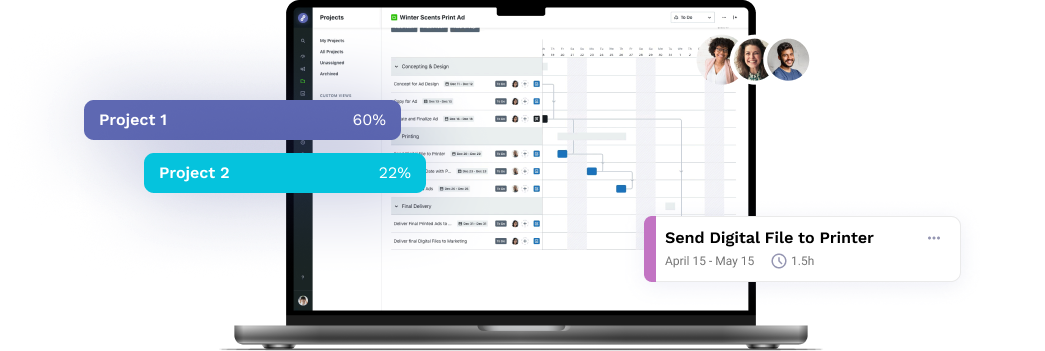
When it comes to managing creative work, there is some confusion about what different job titles mean. Many creative teams also wonder whether they need any or all those job positions to manage their work effectively. Two of the top job positions that cause such confusion are those of the traffic manager and the project manager. Many in-house creative teams wonder:
- What is the difference between a Traffic Manager and a Project Manager?
- Does a creative team need both a Traffic Manager and a Project Manager?
Traffic Manager vs Project Manager
Traffic Managers oversee workflow for the entire creative department. They touch every project at key points in the project lifecycle, like intake. Project Managers manage individual projects for their entire lifecycle.
Traffic Managers have a bird’s eye view of the workload for the entire department. As such, they can route work to keep the department’s workload balanced. Project Managers are given client relation responsibilities. These include managing expectations by producing high-quality work on time and within budget.
Traffic Managers focus on the “behind the scenes” creative work. This includes managing the creative workflow platform, pulling reports, and administering project components.
A Closer Look
Let us take a deeper look at how each role contributes to the creative team.
Project Managers are all about an individual project’s ROI. They live in their projects and are familiar with every detail, and their primary goal is producing high-impact work. Sometimes their compensation may even have a performance component. When it comes time to send proof for review, project managers are the first on the route. When clients requests changes, the project manager has to figure out their impact on the rest of the project.
Traffic Managers, on the other hand, are all about team efficiency. They keep the whole team running smoothly by:
- Managing team resources
- Stepping in at key points in the project lifecycle
- Completing important administrative tasks
Let us take a new project that includes a creative brief as an example. The traffic manager helps the client to submit all the necessary information. Then, they assign the appropriate resources and people to the project.
During the project, they may oversee collating status reports for all active projects to maintain transparency across the team. When projects are complete, they close out the work, store files appropriately, and oversee all final administrative tasks for the project.
Do You Need a Traffic Manager or a Project Manager?
So, do you need a Traffic Manager or a Project Manager, or both? The ideal answer is both – as you can see, each has a unique role that is important for the success of creative work. However, for many smaller in-house creative teams, two new positions may not be a reasonable request. So, if you could only hire one new person, which do you pick? Here are some things to consider:
What Are Your Team’s Biggest Challenges?
If your team is struggling with overall capacity challenges and just trying to keep up with demand from clients, then a Traffic Manager is going to make a bigger impact for your team. However, if you are having trouble managing clients or hitting project deadlines, a Project Manager can make a real difference.
Could Another Team Hire a Project Manager?
Depending on an organization’s structure, the Project Manager might not even be on the creative team, and thus coming out of the creative budget. It is common for a non-creative person to manage a cross-functional project that needs creative work and input from other departments.
Additionally, Project Managers tend to be in more senior positions, and the best project managers usually have several years, or even a decade plus, of experience. This highlights just how important good project management is, and how much value Project Managers can add, but that can be a big hire for a small or even mid-size in-house creative team. If project managers can be cross-functional and sit under another department, it makes more sense for the creative team to focus on hiring dedicated resources.
Can You Make the Traffic Manager Role Bigger?
Traditionally, the Traffic Manager position is thought of as an entry-level position. It is mostly administrative, and with modern creative workflow management software, it is easier than ever. On the one hand, an entry-level hire might be more accessible, but on the other hand, you do not want to find yourself with high turnover as your Traffic Managers mature out of their role. You can combat this by combining or transforming your Traffic Manager position into a Creative Operations role.
Creative Operations covers a lot of the same areas that traffic does but is a more advanced position as it is all about setting up systems and processes that make the creative team more efficient. This can cover everything from building intake forms, managing the creative workflow system of record, and reporting on creative operational KPIs. Again, larger teams will benefit from breaking out roles as much as possible, but for smaller teams looking to get the biggest bang for their buck, hybrid roles offer a better ROI.
Are you interested in tools that will help you improve creative operations and provide you with the support needed for all future projects? Lytho helps you streamline your entire workflow and harmonize all brand collateral under a single, uniform platform. Feel free to reach out to us by scheduling a demo and learning how our creative solutions can boost the effectiveness of your creative projects. We look forward to speaking with you!
Do you want to give yourself and your creative team more room for creative stimulation by automating the boring stuff? Lytho helps you streamline your entire workflow and harmonize all brand collateral under a single, uniform platform. Feel free to reach out to us by scheduling a demo and learning how our creative solutions can boost the effectiveness of your creative projects. We look forward to speaking with you!

Ready to simplify your creative operations and start having a little fun at work again? Schedule time to talk with us.
Let us show you how Lytho’s Creative Operations Platform helps in-house creative and marketing teams do better work, ease the stakeholder experience, and stay on brand.
Schedule a Demo